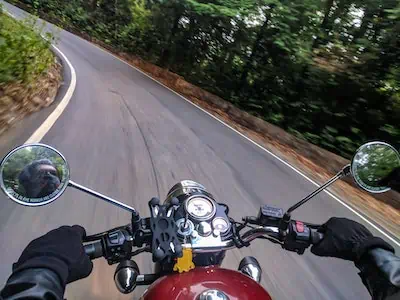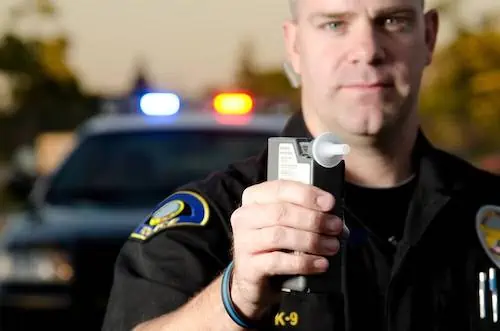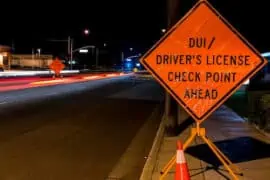A motorcycle ignition interlock device connects to the bike’s ignition system. It features a mouthpiece that you blow into to start the vehicle.
The device measures the rider’s blood alcohol content (BAC). If the amount is above the limit programmed, the motorcycle will not start. You must provide a clean sample or wait for the timed lock to expire.
Didn't You Try Our Quote Comparison Tool Yet? Save BIG by Doing it!
An ignition interlock device requires periodic breath samples for motorcycle use even after starting the engine. This feature is called a “rolling retest.”
It’s required because someone could theoretically have another person breathe into the machine to start the bike.
If you fail the rolling retest, the device sounds an alarm warning to stop the engine. It logs all activities, including successes, failures, and BAC levels, to send to licensing agencies or the court system.
Table of Content
Can You Put an Ignition Interlock on a Motorcycle?
Research indicates that no technical barriers exist to encourage the widespread use of IIDs on motorcycles. Since most state standards require regular testing during vehicular operation, the safety threat of using this technology is a credible safety hazard.
Since a small fraction of ignition interlock devices gets installed on motorcycles, the industry isn’t incentivized to create specific technologies for this need. Most riders who need one can either apply for a waiver or be ordered off the bike to have the IID placed in a car instead.
If the waiver for an ignition interlock device for motorcycle use is approved, that doesn’t mean SR-22 insurance is also taken out of the equation. Riders will need this certificate filed to ensure they receive their license back and have appropriate protections based on the court orders.
How Reliable Are Motorcycle Ignition Interlock Devices?
The technology behind IID for motorcycle use is remarkably effective. A 15% reduction of alcohol-related car accident fatalities occurs in states that mandate them for all drunk-driving offenders.
It’s also important to note that interlock devices have also caused accidents. The rolling retest requires drivers to lift a hand off the wheel, pick up the device, and blow hard into the mouthpiece for several seconds.
In an accident in Texas, the driver passed his test but dropped the interlock after. He fumbled for it, then hit a car backing out of a driveway.
That’s the biggest disadvantage of IIDs. They can cause distracted driving issues.
What States Allow Interlock Ignition Devices (IIDs)?
Most IIDs are ordered by a licensing agency or the court after a rider is convicted of a DUI offense.
Some riders voluntarily install an IID because it might lower their SR-22 insurance rates after a DUI. There is currently no national standard available in the United States for using or installing an ignition interlock device on a motorcycle after any DUI-related offense, including DWI, OWI, or OVI.
Five states don’t have any ignition interlock rules: Indiana, Montana, North and South Dakota, and Wisconsin. Another nine states have no policy involving the use of IIDs on motorcycles.
In California, it depends on the county where you live. Even as a first-time offender, you might be required to have an IID installed to reinstate your driving privilege in Alameda, Los Angeles, Sacramento, and Tulare Counties
If you only drive a motorcycle and cannot install an IID, you can apply for a waiver based on your circumstances. You’ll need to prove that you don’t own other vehicles and not purchase one until your SR-22 motorcycle insurance period ends.
When Would I Need to Install an IID?
An ignition interlock device is only required in nine states when a first-time DUI offense involves a high BAC when arrested. That figure is usually 0.15 or more. Those states are Florida, Kentucky, Michigan, Minnesota, New Jersey, North Carolina, Pennsylvania, South Carolina, and Wyoming.
In 15 states, you could be required to spend some time with an ignition interlock device to reinstate your driving privileges. These include Alaska, Arizona, California, Connecticut, Delaware, Hawaii, Idaho, Kansas, Maryland, Nebraska, Nevada, New Mexico, New York, Oregon, Utah, and Washington.
The remainder of the states except the five that don’t have laws require some type of post-conviction DUI suspension IID installation to return to your vehicle – including a motorcycle.
How Does a Breathalyzer Work on a Motorcycle?
Can you put a breathalyzer on a motorcycle? In most circumstances, it is possible.
An ignition interlock device connects to the ignition system of the motorcycle. Unlike the installation process in cars, the IID for a bike must consider vibrations, jostling, power draw, weather exposure, dust encounters, and secure storage.
To avoid the issue of precipitation and dust exposure, weatherproof boxes are installed on motorcycles when IIDs are necessary. Since some states require all vehicles, including boats, to have this technology, the sealed case keeps moisture away from the components. Some systems use cameras that require protection when you’re not riding.
Moreover,
Rolling retests use auditory signals on motorcycles to ensure the rider sees the requirement. It’s arguably the biggest problem with this technology. Submitting a breath sample while riding creates several safety issues. That means you’re almost forced to pull to the side of the road to complete the test, creating another set of safety hazards to manage.
Some manufacturers use an LED notification that mounts in the driver’s vision to alert them when a retest is necessary. That prevents riders from looking down or having their attention distracted. Retest times vary by state, but IID retests are fast and user-friendly.
If the court requires you to install an ignition interlock device, you’ll be provided with a list of approved vendors to complete the work on your motorcycle.
Anything Else to Know About Motorcycle IIDs?
Riders that must have an ignition interlock installed must pay for its costs. That includes $75 to $150 for the device and the labor to attach it to the vehicle, and a monthly monitoring fee of $100 or more.
That means the annual cost of maintaining this device is $1,000 or more. Those expenses are in addition to the higher insurance premiums and other requirements after a DUI conviction.
If you have an IID installed, the safest way to retest is to pull over to the side of the road whenever possible.
Use This Tool for Free and Save on Quotes!







